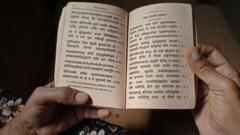In a fascinating interplay between food aid and intellectual enrichment, India's historical food shortages unexpectedly led to an abundance of South Asian literature in American libraries. The initiative, known as PL-480, was launched in 1954 under Public Law 480—commonly referred to as the Food for Peace program. This U.S. effort aimed to provide food aid to countries facing crises whilst simultaneously mitigating American grain surpluses during the Cold War.
India emerged as one of the largest beneficiaries of this initiative, particularly in the 1950s and 1960s when it battled severe food shortages. The program allowed India to purchase U.S. grain using local currency, facilitating the funding of book purchases for various American universities. This unexpected cultural exchange significantly enriched the collections of institutions like the University of Chicago, which boasts over 800,000 volumes dedicated to South Asian studies.
Ananya Vajpeyi, a visiting professor at Ashoka University and an alumna of the University of Chicago, recalls the treasures she found in the Regenstein Library's South Asia collection. Through a specialized program, the library managed to access an extensive array of materials, including books, periodicals, and multimedia in multiple Indian languages. This effort, deemed revolutionary for South Asian studies, was made possible by a dedicated team based in Delhi who helped procure relevant materials from a vast geographic and linguistic landscape.
James Nye, director of the Digital South Asia library at the University of Chicago, remarks on the profound impact of PL-480. By the late 1960s, over 750,000 titles from South Asia had been shipped to American libraries, dramatically transforming their academic resources. However, as the program thrived, questions arose about the ramifications of sourcing such materials from India. Critics, including Todd Michelson-Ambelang from the University of Wisconsin-Madison, worry about the potential depletion of regional knowledge resources, necessitating that scholars from South Asia journey to the West for access to materials now largely stored outside their countries.
While many of the acquired books remain preserved in American libraries, the ongoing challenge of resource management in India’s libraries raises concerns. Many books that once thrived in their native environment are now difficult to find due to issues like pests and inadequate preservation techniques. In contrast, Western institutions maintain robust archival systems, reflecting a stark inequality in the availability of knowledge.
Despite the complexity of this historical arrangement, Ms. Vajpeyi appreciates the positive outcomes of the books-for-grain program. Her experiences at the University of Chicago allowed her to navigate multiple languages and disciplines, underlining the importance of well-resourced libraries. She highlights a grim reality for Indian libraries, often plagued by neglect, which starkly contrasts with the well-preserved collections in the U.S.
As PL-480 gradually phased out in the 1980s, the financial burden shifted to American libraries, prompting significant annual expenditures, particularly in institutions like the University of Chicago. The legacy of this program remains multifaceted, illustrating how an initiative aimed at alleviating food shortages inadvertently reshaped cultural landscapes and academic discourses across borders.

















